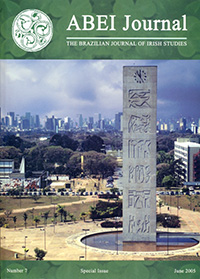Death and the Playwright:Chris Lee’s The Electrocution of Children (1998) and The Map Maker’s Sorrow (1999)
DOI:
https://doi.org/10.37389/abei.v7i1.184211Keywords:
Chris Lee, The Electrocution of Children, The Map Maker’s SorrowAbstract
The award-winning Irish playwright Chris Lee’s The Electrocution of Children (1998) was produced at the Peacock Theatre in 1998 while The Map Maker’s Sorrow became the Abbey entry in the 1999 Dublin Theatre Festival. The Electrocution of Children, an intellectually ambitious play depicts a world in which people have forgotten how precious the gift of life is, and how fragile human beings are. Characters in the play squander opportunities to be creative, turn their backs on relationships, fail in their attempts to communicate, and prey upon one another. Like the characters in Alfred Jarry’s Ubu Roi (1896), those in Lee’s play often appear to be wayward children who fail utterly to follow any rules of logic or propriety. The play itself moves sequentially through a series of scenes drawn from the debris of lives and the isolation of relationships. In contrast, The Map Maker’s Sorrow begins abruptly and confusingly with the suicide of a character the audience has not met and, therefore, does not know and then proceeds through no clear development to a harmonious end. (The play’s structure reflects Lee’s use of a map’s “simultaneous spatial logic” [40]). At the very beginning of the play, the audience finds itself in a position similar to that of the bereaved family in the play or that of any survivors who find a member of their family dead by his or her own hand. Suicide, like Lee’s opening scene, declares the strangeness of the other that the play then explores.
References
Alvarez, A. The Savage God. Harmondsworth: Penguin, 1971.
Auden, W. H. The English Auden. Ed. Edward Mendelson. New York: Random. 1977.
Beaumont, Keith. Alfred Jarry: A Critical and Biographical Study. New York: St. Martin’s Press, 1984.
Bailey, Paul. “Introduction.” In Levi. ix-xvii.
Beckett, Samuel. Waiting for Godot. New York: Grove, 1954.
Bernstein, Max B., Scott A. Sandford, and Louis J. Allamandola. “Life’s Far-Flung Raw Materials.” Scientific American (July 1999): 26-33.
Burton, Robert. The Anatomy of Melancholy. 3 vol. 1621 London: Dent, 1932.
Camus, Albert. The Myth of Sisyphus and Other Essays. New York: Vintage, 1995.
Davies, Paul. The Fifth Miracle: The Search for the Origin of Life. 1998 London: Penguin, 1999.
____. The Last Three Minutes: Conjectures about the Ultimate Fate of the Universe. New York: Basic Books, 1994.
Gould, Stephen Jay. Full House. New York: Three Rivers Press, 1996.
Hawton, Keith. Suicide and Attempted Suicide Among Children and Adolescents. London: Sage, 1986.
Joyce, James. “The Dead.” 1914. The Essential James Joyce. Ed. Harry Lavin. London: Frogmore, 1977, 138-73.
Jamison, Kay Redfield. Night Falls Fast: Understanding Suicide. New York: Vintage, 1999.
Jarry, Alfred. Ubu Roi. Tout Ubu. Paris: Librairie Générale Française, 1962, p. 15-131.
Lee, Chris. The Electrocution of Children. Unpub., n.p.
____. Letter to the author, August 1998, n.p.
____. The Map Maker’s Sorrow. London: Faber, 1999.
Levi, Primo. The Drowned and the Saved. Trans. Raymond Rosenthal. 1988. London: Abacus, 1989.
Louise, Dorothy. “Observe the Irish Playwrights Marching Towards the Screen.” Irish Theatre Magazine, 1:4, 1999, p. 19-23.
May, Rollo. Freedom and Destiny. New York: Norton, 1981.
Miller, Arthur. Death of a Salesman: Certain Private Conversations in Two Acts and a Requiem. 1949. Harmondsworth: Penguin, 1969.
Morse, Donald E. “ “To Cry with Terror”: Crossing the Ultimate border in Chris Lee’s The Map Maker’s Sorrow.” Beyond Borders: IASIL Essays on Modern Irish Writing. Ed. Neil Sammells. Newton Park: Sulis, 2004. 223-38.
____. “‘The Simple Magnificence of Bacteria’: Chris Lee’s The Electrocution of Children.” Irish Studies Review, 8:1 (2000): 91-98.
Pinker, Steven. Interview with Alden M. Hayashi. “Profile: Pinker and the Brain.” Scientific American. July 1999, 18, 20.
Plath, Sylvia. “Lady Lazarus.” The Collected Poems. Ed. Ted Hughes. New York: Harper & Row, 1983. 244-47.
Roche, Anthony. Contemporary Irish Drama from Beckett to McGuinness. Dublin: Gill & Macmillan, 1994.
Sartre, Jean-Paul. Huis Clos. Huis Clos suivi de Les mouches. Paris: Gallimard, 1947.
Shattuck, Roger. “Introduction.” Selected Works of Alfred Jarry, ed. Roger Shattuck and Simon Watson Taylor. New York: Grove, 1965.
Stevens, Wallace. “Sunday Morning Service.” The Palm at the End of the Mind: Selected Poems and a Play. Ed. Holly Stevens. New York: Vintage, 1972. 5-8.
Whitman, Walt. “When Lilacs Last in the Dooryard Bloom’d.” Leaves of Grass. Ed. Sculley Bradley and Harold W. Blodgett. 1965. New York: Norton, 1973. 328-37.
Wilder, Thornton. Our Town. 1938. Thornton Wilder: Our Town, The Skin of Our Teeth, The Matchmaker. Harmondsworth: Penguin, 1965. 15-91.
Downloads
Published
Issue
Section
License
Copyright (c) 2005 Donald E. Morse

This work is licensed under a Creative Commons Attribution-NonCommercial 4.0 International License.


